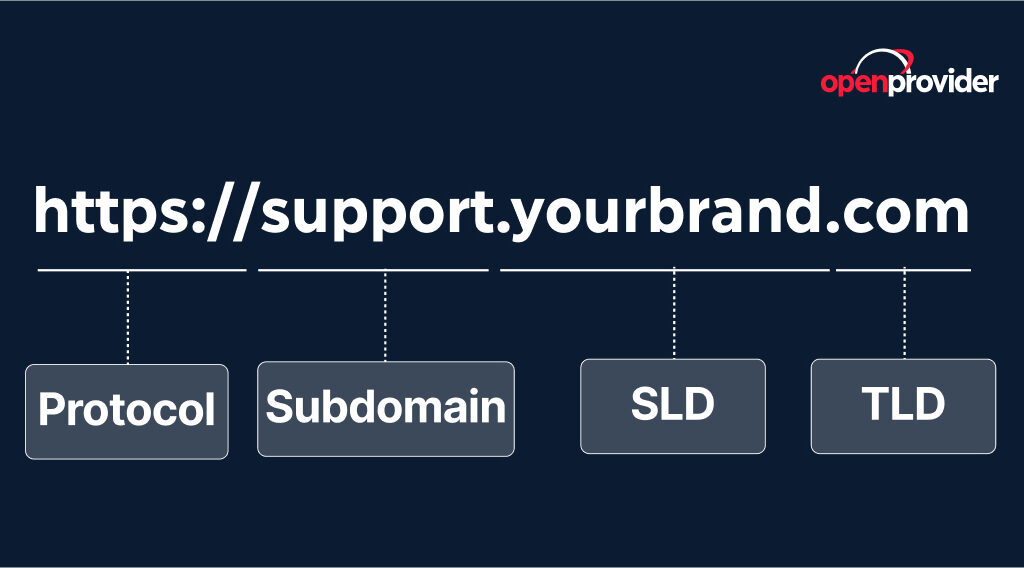Introduction
To understand what is the domain name of a website, we can look at it from both a technical and strategic perspective.
A domain name represents the identity of a business or brand and, for this, domain resellers and digital investors consider factors like its typology, its relationship with the users’ search and – hence – its potential sales value.
But what exactly is a domain name, how does it work, and why is it so critical to your business? In this guide, we’ll address these questions, helping you make smarter decisions and understand the technical and business relevance of domain names.
Understanding domain names
A domain name is the alphanumeric, human-readable address of a website.
It serves as a pointer, or a label that tells the internet where your website is hosted. Every domain name is mapped to a numerical IP address via the Domain Name System (DNS), allowing users to reach your site without memorizing a string of numbers.
Think of it as your online real estate. Just like a physical address helps people locate your business, a domain name makes your online presence findable and memorable.
A domain name has several purposes:
- It identifies your website uniquely on the internet.
- It builds credibility and trust with your audience.
- It reinforces your brand and has a correlation with SEO.
- It serves as the foundation for your email, hosting, and SSL infrastructure.
For businesses that resell domains or offer web and IT services to their customers, domain names are key assets, often bundled into larger services like hosting packages, site development, or digital branding, and managing them efficiently can save time, reduce costs, and improve client retention.
Structure of a domain name
To understand how domain names function, it helps to break them down into their basic components. A domain name consists of several elements, each serving a specific purpose within the Domain Name System (DNS).
1. Top-level domain (TLD)
This is the last part of the domain name — the extension that comes after the final dot, such as .com, .org, .net, or newer alternatives like .tech or .agency. TLDs are managed by registries under the oversight of ICANN (Internet Corporation for Assigned Names and Numbers), and they fall into different categories:
- Generic TLDs (gTLDs) like .com, .info, or .xyz
- Country code TLDs (ccTLDs) like .nl (Netherlands), .de (Germany), or .es (Spain)
- Sponsored or restricted TLDs like .edu or .gov, with limited eligibility
2. Second-level domain (SLD)
This is the part of the domain name that comes before the TLD. In openprovider.com, openprovider is the SLD. It’s the unique name that typically represents a brand, business, or individual. This is the part that customers remember and associate with your identity online.
3. Subdomain
A subdomain appears before the second-level domain and is separated by a dot. For example, in blog.yourwebsite.com, blog is a subdomain.
Subdomains are often used to organize key web areas or specific services, such as separating a support portal from a main site or isolating test environments during development.
Here’s a practical breakdown:

Each of these elements plays a role in how a domain is structured, resolved, and presented to users.
For domain resellers, web hosters and marketing agencies, understanding these components is key to structuring their services efficiently and avoiding client confusion.
Types of domain names
Not all domain names are created equal.
They serve different purposes, target different markets, and follow different rules depending on their format and intended use.
Understanding the main types of domain names helps businesses and resellers make informed decisions when registering or recommending domains.
1. Generic top-level domains (gTLDs)
These are the most widely recognized domain extensions. Examples include .com, .net, .org, and newer options like .ai, .io, and .tech. They’re open for registration by anyone, making them versatile for businesses, startups, and individuals alike.
2. Country code top-level domains (ccTLDs)
These represent specific countries or regions – like .de (Germany), .es (Spain), .nl (Netherlands), or .co.uk (United Kingdom). ccTLDs are often favored by local businesses that want to signal trust and relevance within a specific geographic market.
3. Sponsored and restricted TLDs
Sponsored TLDs are backed by private organizations or agencies that enforce specific usage rules. Examples include:
- .edu (educational institutions in the US)
- .gov (governmental use)
- .bank, .insurance, and others that may require additional verification and follow strict security protocols
These TLDs signal legitimacy but are not available to the general public.
4. Brandable domains and custom TLDs
Some companies register their own brand TLDs (e.g. .google, .bmw) under ICANN’s new gTLD program. These are typically used for internal consistency, marketing, and security.
Agencies and hosters can benefit from offering brandable domain name combinations that are short, relevant, and easy to remember, even if they use traditional TLDs like .com or .net.
5. Internationalized domain names (IDNs)
These domain names include characters from non-Latin scripts, such as Arabic, Cyrillic, or Chinese. IDNs are important for global inclusivity and help businesses localize their web presence in native languages.
Choosing the right domain name
Selecting the right domain name is a branding decision that impacts your online visibility, customer trust, and long-term business success.
For agencies, IT providers, and resellers, advising clients or making these decisions at scale means balancing creativity with technical and commercial strategy.
For investors and resellers ready to select their assets, we’ve crafted a thorough guide on how to analyze and choose a domain name profile.
In short, here are some key points to consider.
Make it a simple and memorable name
The best domain names are short, clear, and easy to remember.
Avoid complex spellings, hyphens, or numbers that can confuse users: a domain should pass the “radio test” – if you say it aloud, someone should be able to spell it and find it easily.
Reflect your brand and talk to your audience
The domain should match or complement the brand name whenever possible.
If your exact match isn’t available, consider close variations, location-based alternatives, or new TLDs that fit your industry or area, such as .agency, .tech, or .shop.
This is particularly useful for web designers and marketing agencies building a consistent brand portfolio.
3. Choose the right TLD for your market
- .com is universally trusted and works globally
- Country-specific TLDs like .nl, .de, or .es help localize your offering
Niche TLDs like .shop, .design, or .ai signal specialization
Openprovider offers more than 1,900 TLDs at cost price, making it easy for resellers and digital service providers to match domain names to client needs, or to explore new markets with relevant options.
Think about SEO and discoverability
While exact-match domains don’t guarantee top rankings, a clear, keyword-friendly domain can improve your visibility in search engines.
For example, a domain like madridwebdesign.es instantly communicates location and service.
For agencies managing multiple clients, this approach also helps streamline SEO strategies across portfolios.
Future-proof your choice
Choose a name you can grow with. Trends and products may change, but a solid domain provides long-term value.
Avoid overly narrow or time-sensitive terms that could limit your future positioning, unless you’re aiming to sell trend-based domains by exploiting other domain strategies.
Check availability and reputation
Use a trusted registrar or API integration to check domain availability in real time.
Also, verify WHOIS records and previous ownership history before buying a name: domains with a shady past can carry negative SEO weight or security risks.
Registering a domain name
Once you’ve found the perfect domain, the next step is to register it quickly and securely.
For businesses, digital agencies, and resellers, domain registration isn’t just a one-time action; it’s a critical touchpoint that affects everything from customer onboarding to long-term portfolio management.
Reliable domain registrars standing out
A domain registrar is a company accredited by organizations like ICANN to sell domain names.
When selecting a registrar, either for your business or for your clients, consider:
- Direct accreditations (Openprovider supports 1,900+ TLDs via 179+ direct accreditations)
- Transparent pricing (look for cost price structures, especially if you manage many domains)
- Security standards (ISO 27001 certification, WHOIS privacy, DNSSEC support)
- Support for automation (API, plug-ins, bulk tools)
Registrars like Openprovider also offer Membership models, which give resellers access to domain operations at cost price, ideal for scaling with predictable margins.
Tracking availability
Use a registrar’s search tool or API to check if a domain is available.
This is especially important for resellers and web agencies integrating domain services into their own platform: you want accurate, fast availability checks without delays.
If the domain is already taken, consider alternatives such as:
- Slight name variations
- Alternative TLDs (.net, .tech, .design)
- Premium domains or domains on aftermarket platforms
Crossmarking accurate registration details
Every domain must be registered with valid ownership information. This includes:
- Registrant name and organization
- Contact details (email, address, phone number)
- Admin, billing, and technical contacts
Accuracy is important not just for compliance, but for recovering access or proving ownership later. If you’re managing domains for clients, consider using role-based contacts or white-labeling options to simplify management.
Making your domain secure
Enable security features during registration whenever possible. For example:
- Enable WHOIS privacy (included for free for Openprovider members)
- Use DNSSEC for added protection against DNS spoofing
- Set up auto-renewal to avoid accidental expiration
Advanced users, such as hosters or IT providers, can use APIs to automatically apply these settings across multiple domains, ensuring consistency and uptime.
Registering multiple complementary domains
Protecting your brand or business often means registering more than one domain:
- Common misspellings or variations
- Localized TLDs for target geo markets
- Blocking potential brand misuse by registering competitors or typosquatting versions
A registrar that offers easy bulk registration and transfer tools makes this process faster and more efficient, a critical feature when managing hundreds or thousands of domains across clients.
Managing and protecting your domain
Registering a domain is just the beginning. Whether you manage a single business website or a portfolio of thousands of domains, maintaining control, visibility, and security over your assets is essential.
Use a centralized management platform
Efficient domain management starts with the right tools.
A unified dashboard, like Openprovider’s Reseller Control Panel (RCP), helps you:
- View and manage all domain operations (registration, renewal, transfer, updates)
- Apply bulk actions to save time
- Handle DNS, WHOIS, and ownership records efficiently
- Consolidate your billing, notifications, and account access in one place
For high-volume users or those offering domains as part of a service package, integrating with a domain API ensures scalability and automation across your workflow.
Keep your records up to date
Always maintain accurate registrant and contact information. Outdated data can lead to:
- Failed domain transfers or renewals
- Security risks or compliance issues
- Loss of ownership in dispute cases
Use role-based emails (e.g. domains@youragency.com) for contact fields to avoid disruptions when staff change.
Enable domain locking and DNSSEC
Domain locking prevents unauthorized transfers or tampering.
For added protection, DNSSEC (Domain Name System Security Extensions) validates DNS records and guards against spoofing and hijacking attempts.
These features are especially relevant for:
- Domain resellers with a consistent portfolio under management
- Agencies managing sensitive or high-traffic domains
- eCommerce sites
- Government or public service portals
Hint: most of these settings can be enabled by default for Members through Openprovider’s API or during bulk registration.
Monitor renewal dates and use auto-renew
Losing a domain due to an expired registration can mean lost traffic, broken email systems, or even reputational damage. Avoid this by:
- Enabling auto-renew by default
- Monitoring upcoming renewals via your dashboard or integration
- Registering domains for multiple years to reduce admin overhead
5. Prevent domain abuse and disputes
For domain resellers and hosters, reputation matters. Domains tied to scams, phishing, or abuse can quickly escalate into customer support issues or regulatory risks.
To manage this proactively:
- Monitor WHOIS data and DNS activity regularly
- Use registrar tools or abuse management workflows
- Choose a registrar with a proven record of compliance (Openprovider is ICANN-accredited and ISO 27001 certified)
You can also add domain privacy protection and register key brand variations to block bad actors.
Conclusions
From choosing the right domain and extension to registering, securing, and managing it over time, the domain lifecycle is full of opportunities to add value for your clients, or for your own digital presence.At Openprovider, we’ve spent two decades helping businesses streamline domain management with cost-price operations: for any additional information, we’re here to make domain management simpler, more profitable, and fully under your control.




